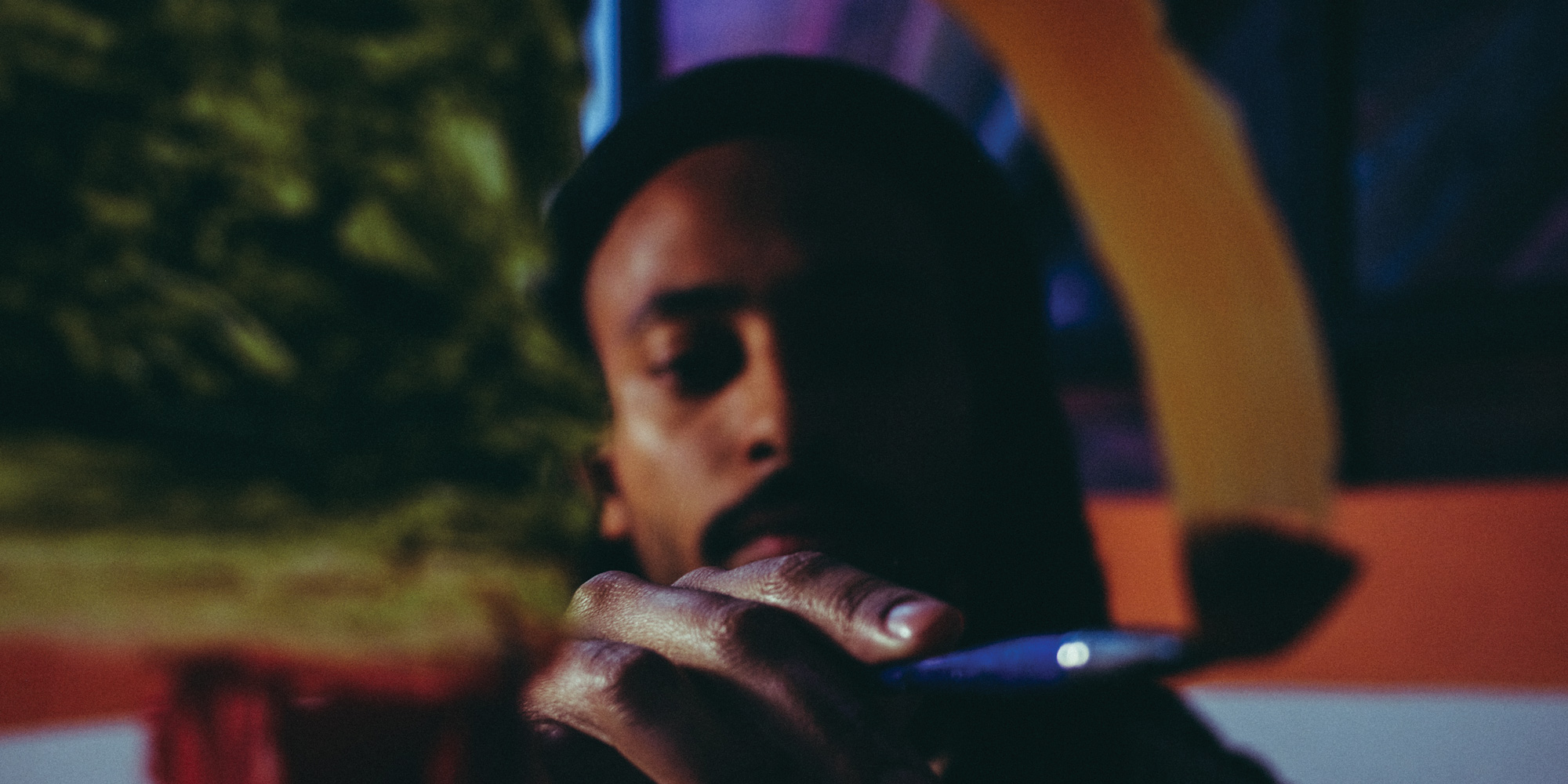
Muzae Sesay
Living One Life
Interview by Eben Benson // Portrait by Cinque Mubarak
There are countless paths to becoming an artist, regardless of what any individual might suggest or recommend. To many, it may seem a futile pursuit, often not as glamorous as imagined and even more often, not as lucrative. But ask a handful of successful artists about their path, and you’ll hear surprising stories about “pre-art” careers that might make one revise any big predictions about a young person’s future. One timely example is the author of this month’s Travel Insider, Mike Shine, who had a highly successful career in advertising before becoming the freewheelin’ painter he is now. Or consider The Report’s Pat Perry, whose paintings have far outgrown their previous associations with his train-hopping, hitch-hiking lifestyle.
The list gets exhaustive, so let’s cut to the chase and consider Muzae Sesay. A born artist, he tinkered with toys from a young age, listened to odd music, skateboarded, and generally wandered off the prescribed path. When it came time to go to college, he studied sociology at SF State, curious and hungry for knowledge, painting all the while and perfecting his precise brush strokes. He never spent a day in art school, but now is one of Oakland’s most exciting young painters. His unique perspective and technique make paintings and drawings distinctly his own, referencing memories and refining their expression through a steady and practiced hand. He continues to grow his practice to new heights and happily maintains a youthful curiosity about the world, which means he’ll always have plenty to paint.
Sesay and I sat down in his Oakland studio while he fashioned a miniature raft out of markers and scrap wood. Like I said, born artist….
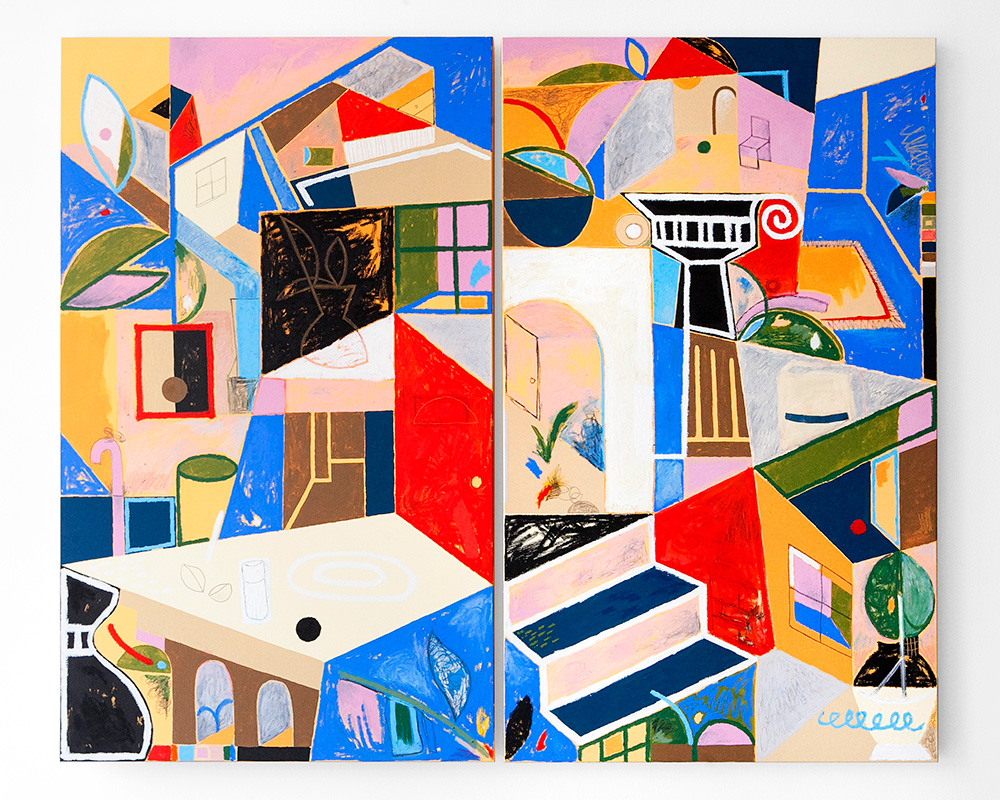
Eben Benson: Where are you from? Who are you? What's the deal?
Muzae Sesay: I'm Muzae Sesay and I was born in Long Beach, California, and lived in Anaheim, California, and then moved to the San Francisco Bay Area.
What brought you to the Bay?
I mean, the Bay brought me to the Bay. It really started with a friend of mine who went to Berkeley. I would come up and visit them with another good friend, and really got to experience San Francisco and the Bay Area from a new lens. It made me feel relaxed and free to be who I wanted to be.
In Orange County, I felt like a black sheep, a token, black artist guy. I had great friends and I love everyone that I grew up with, but no one was really interested in the same things that I was. I was making stuff just for the sake of creating, and it felt like others thought, "Oh, Zae is just some weird kind of ‘art kid.’"
When I’d come up to the Bay, I realized everyone here had their own kookiness, their personalities were eccentric, and they were creating stuff, whether it was music, visual arts, or writing. There was so much diversity, and It was all so inspiring. So I moved here. Of course, that was back at a time when people could just move to SF for fun.
Yeah, and It's definitely changed a little bit since then. When did you start making art?
Some of my earliest memories are of making art. My mother and aunt were really supportive, and I remember that I would make drawings when I was really young, maybe 4 or 5 years old. Every time I made something, they would act like it was some mind-blowing masterpiece. They would hang it up and act like it was the best thing that anyone's ever done. I think I really latched onto that feeling. The idea of me, a brand new person in this world, making something that adults thought was important or valuable gave me a type of satisfaction and self-worth in creating very early on.
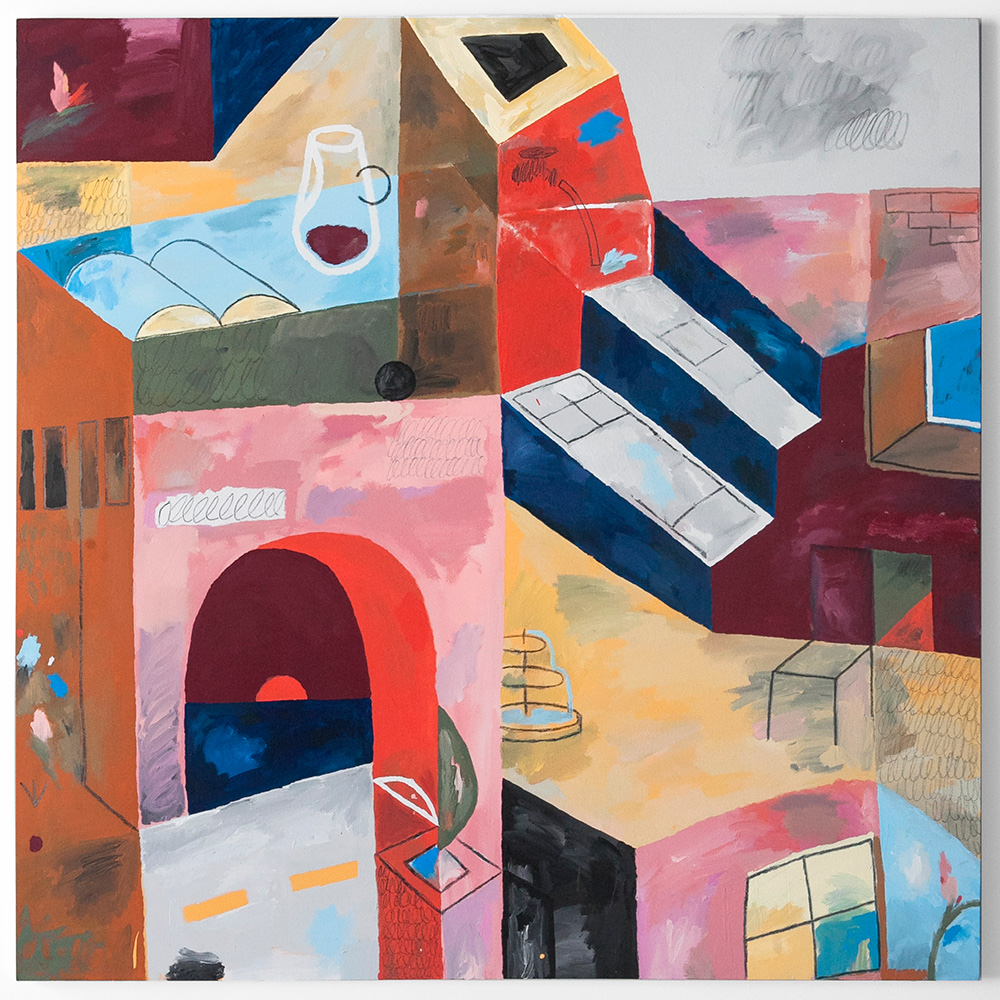
How did that change over the years? What type of creative things were you into?
As a child, I loved taking apart electronics and things that my family had discarded, and turn them into toys or gadgets. My family didn’t have much money, so a lot of my creativity came from necessity. I also really loved Legos. I was obsessed with making weird structures and never really followed the instructions.
Around high school, I really wanted to be an architect. Then, at one point, I wanted to be a car designer, then a fashion designer. I never wanted to focus on one aspect of creating, so those didn’t work out, but I knew that I’d always be interested in those fields. I guess that’s why I enjoyed drawing and painting. I could make anything I wanted and didn’t have to focus.
Was it more about making something the exact way that you wanted it to look?
Yes, definitely. Maybe it was just early narcissism, looking at a car and thinking, "Oh, I could make a car better than that." Same with architecture, looking at structures and then thinking, "This is cool, but I would do it this way."
I would draw a lot of architecture early on, which is kind of funny because I do that in my paintings now, and there was a period where I wasn't doing that. Later, in high school and early college, I wasn't really looking at the structure anymore. I was looking at the figure. I was doing a lot of portraits of my friends, focusing on black-and-white, hard-edge, geometric contrast.
After high school, I really picked up creating stuff as something I did ritually after work or school. I was experimenting more with surfaces, utilizing found materials. I also got really into doing spray paint stencil work, and thinking about things in layers.
But yes, it was always about making something the way I wanted to make it.
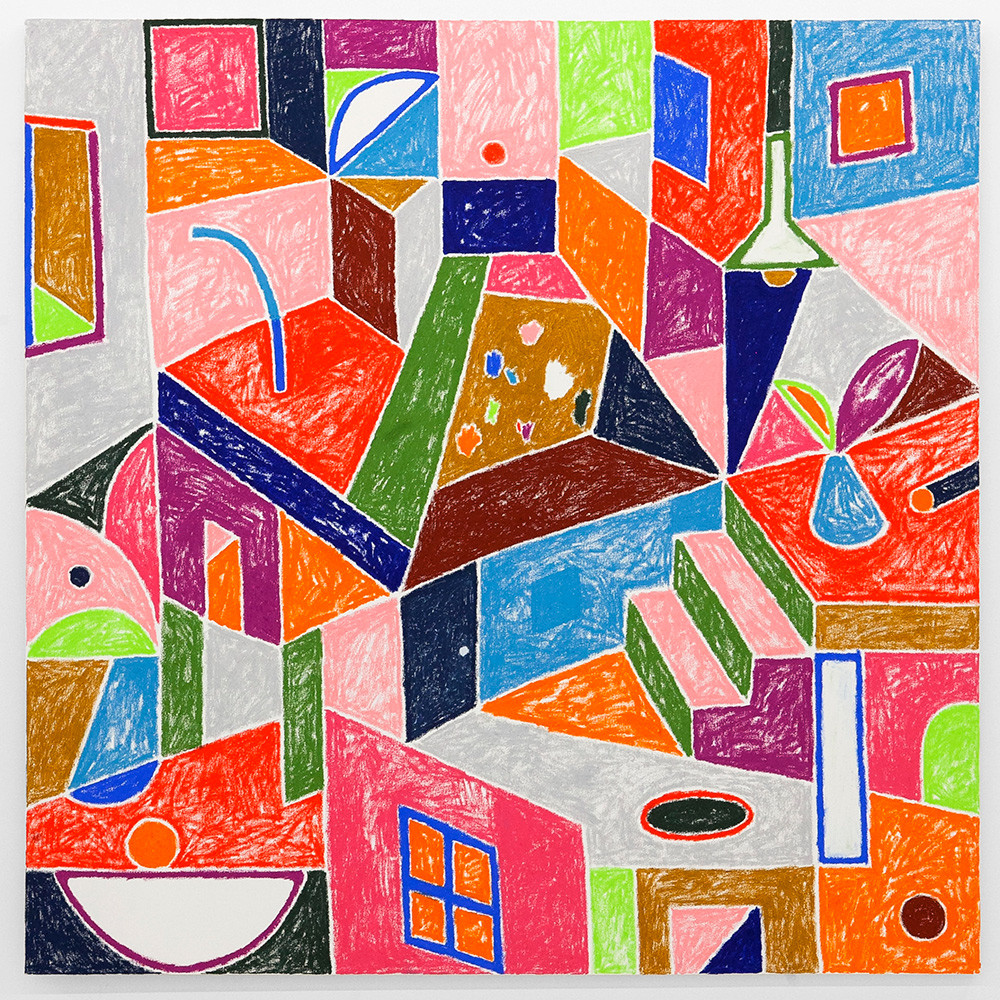
Why do you think you wanted to create art rather than design?
I always made things just for the image of it to challenge myself, to show myself something new. I’m addicted to that feeling. I never wanted or cared to equate it to a job or a commercial field. In fact, I tried to avoid it, fearing it would taint my process and how my work makes me feel.
Don’t get me wrong, I love design and still dabble in it. I just don’t want to work for anyone. I don’t want to manage a client’s concerns. That’s not the way I approach art making, and I want to keep it that way.
Also, by my definition of art making, I didn’t see how I could apply that into capitalism. I had a high school math teacher once tell me that I wouldn’t make a good architect because I wasn’t good at math.
And then you found out that architects don't have to be good at math!
Yeah, I found that out later on in life, that architects don't even do any of the math. I'm like, "You terrible teacher. You were my math teacher. You were supposed to teach me that..." It was actually a silver lining because I moved from trying to think of practical solutions to imagining fantastical realities. I just enjoyed the idea of living in the theoretical. I found it more interesting. In that sense, I could make anything I wanted because it doesn't have to exist outside of the idea of it.
What about the domestic elements in your work, what compels you about those environments?
I think the home does a lot. The way I see it, the home is connected to the most revealing social aspect of a person. I like to think of my work as dealing with social interactions; whether a one-on-one situation, like romance and domestic relationships, or I’m looking at the larger community aspect of things. I love conveying human interactions without using the figure, and looking at the space that humans create tells a lot about the people who occupy those spaces. Ideally, the viewer will put themself into the space and inhabit it with the people they imagine being there. Each viewer is a guest, encouraged to navigate the space with their unique perspective.
The home, specifically, is a crucial, if not the most crucial site for looking at human interactions. There is no space more true to someone than the place they have to themselves. It’s a temple, a sanctuary, a site revealing the interpersonal drama.
“Home” is different than “house”. A house is a structure, and home is wherever life happens. Therefore, home and community can be synonymous. When I say I’m interested in home and community, I’m saying I’m interested in the spaces where life happens.
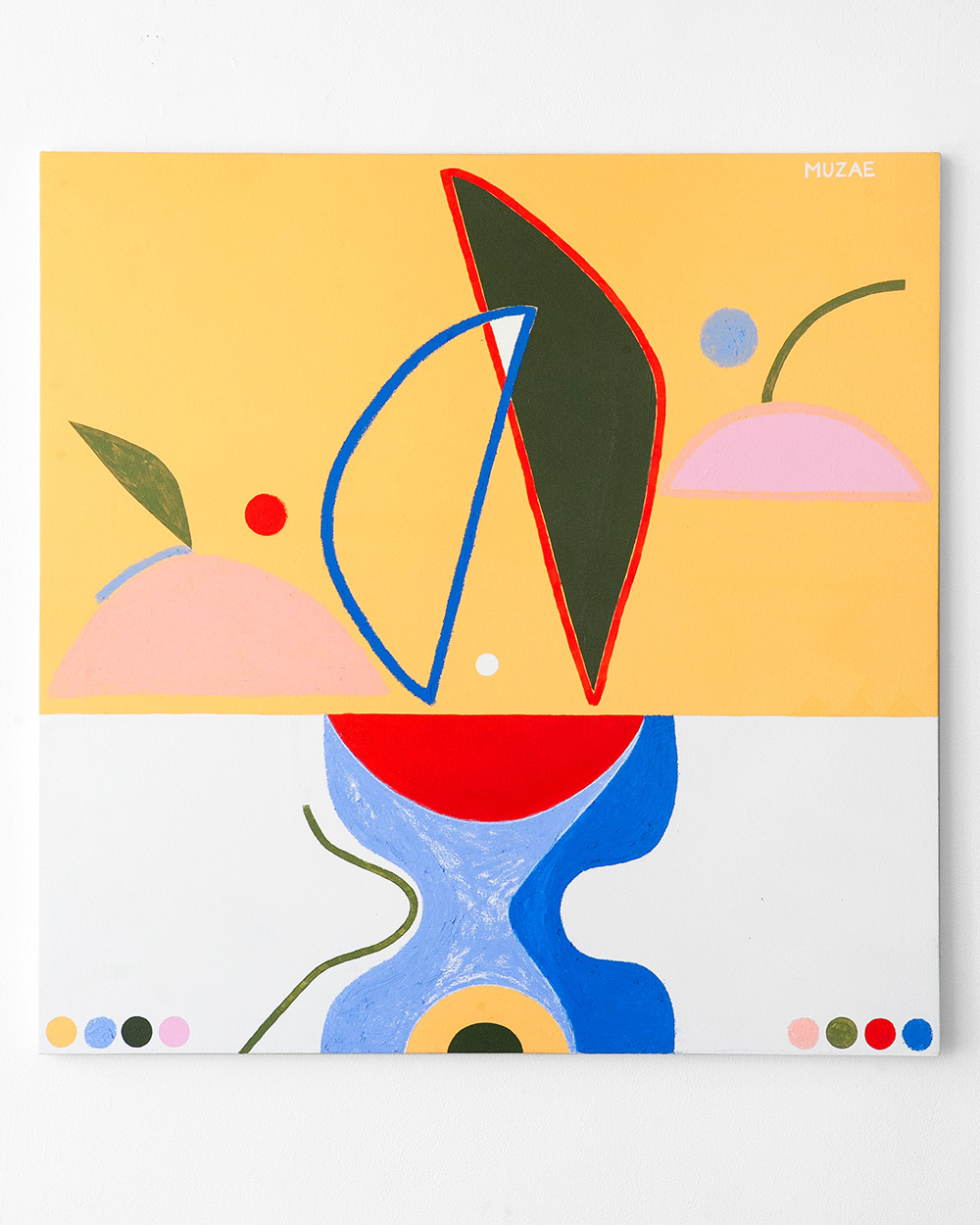
Since you often refer to community in your work, do you think that your degree in sociology sustains your practice more than studying at an art school would have?
I could easily say that, because I didn’t go to art school, and I was able to maintain this aspect of my art being for me, but I’m not sure, since I’ve only lived one life. Since I didn’t go to art school, I never had the pressure of looking at art as a means for financial stability. Even though now, I am pretty much a full-time artist, art has always been just for myself and my community. Studying sociology helped me realize that.
I didn't study sociology to necessarily go into a job in that field. Instead, I thought it was a very valuable concept to study in an academic setting. I found clarity in things that I already thought about, things that we all probably think about. It not only helped inform my art practice, but also helped inform the person I am today and how I think and navigate the world. I could see the differences between communities, and the impact of people on community. It got me thinking about micro-communities, and asking questions like, “Why does San Francisco have an environment that encourages people's houses to all look different and colorful, but not Orange County?” Having those comparisons piqued my interest in the places and spaces that humans create and how that says a lot about the people and their ideas.
There are also a lot of parallels between visual art and sociology. Both are abstract and theoretical with no real “right” or “wrong”. Both function as critiques, rejecting systematic ways of thought. Both push humanity closer to post-modernity. And, in either field, even a child could contest theories of the greatest minds.
How do you find these larger social themes play into your work? For example, your painting technique might be seen as classic European. As a Black American man, what compels you towards that style?
I don’t consider it European at all, especially when you consider where classic Europeans got their influence; African and Eastern culture. I think the idea of blackness comes into play when seeing work that wasn’t made by a black person. Instead of saying, "Oh, well, this isn't for me because no one else like me has done this," I want to say, "Look, black people can do this, black people can do anything. It doesn't matter." I want to show other black creatives that we can make art however we feel like it. Black artists who create work that depicts a straightforward black experience is important, but that’s not our limit. We deserve the luxury and freedom to think beyond that. I don't usually stray away from things because I haven't seen anyone like me do them. I want to do the opposite. It makes me want to do them more because...
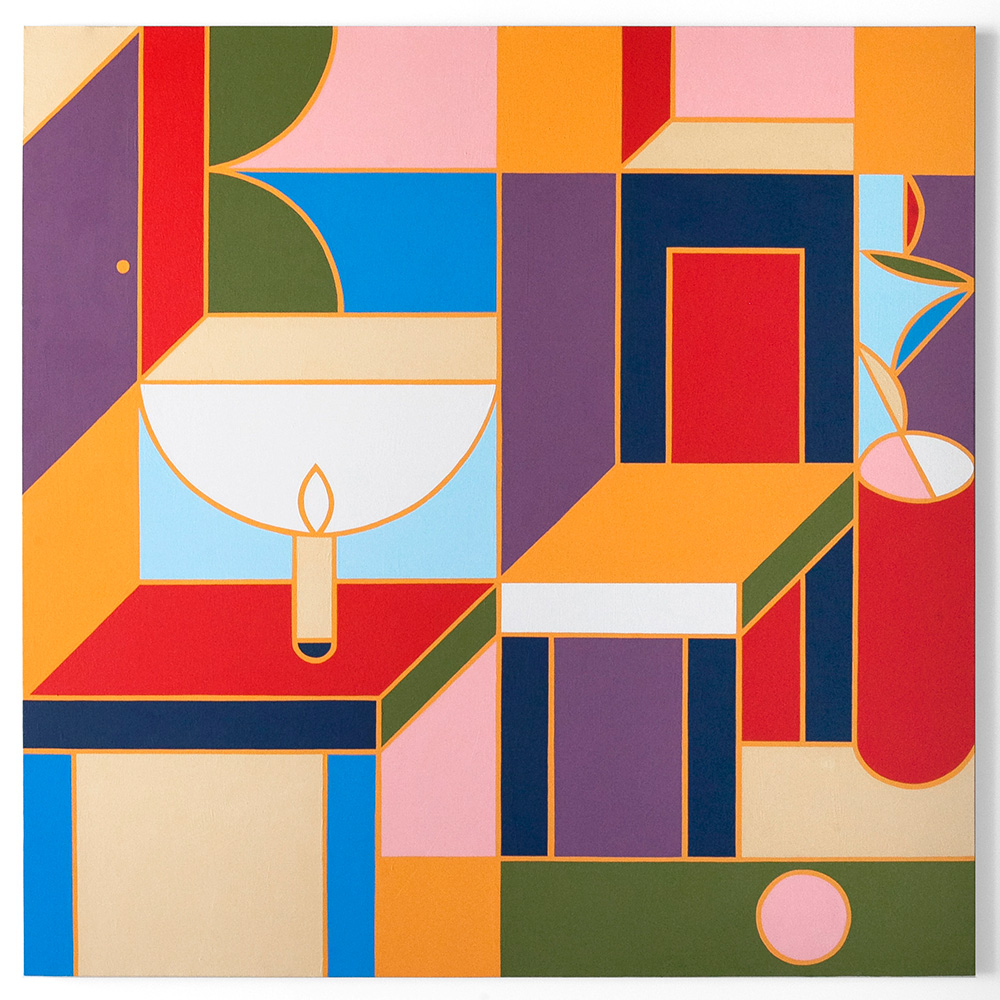
Because you can.
Why not? Because I can. I'm not going to put myself in a box and say that I can't do something just because no one else like me has done it. It's like, "Fuck that."
I am intersectional, and at the core, I am a human. With that, I find myself interested in the macro level themes that tie us all together. As a black male, everything comes from a black lens, and if anyone disagrees, they should reevaluate what “blackness” means to them. Sometimes I want to talk about romance, community, urbanization, memory, adolescence, home, etc. It’s these humanizing concepts that allow us to develop empathy with one another.
Do you find that people have an expectation for you to make a different type of work? Do you feel that, in the current political moment, people expect you to make more provocative or representational art
Of course, all the time, but who cares? Someone recently reacted to seeing my work by saying, "You made this? I thought this was a white woman." I guess because I use a lot of pinks and a lot of traditionally not-masculine colors. This person thought they had my race and gender all figured out and was shocked to see that I was literally the opposite. I can't determine if that was supposed to be a compliment or not. I don't know. In some ways, I liked it, because I want to renegotiate what black masculinity means in America and make work that exposes all aspects of myself. So maybe I opened their mind a little bit.
In some places, it's gotten to the point where it's a fetish, where people, including collectors, want this specific thing from black painters without recognizing the liberty an artist needs for expression.
I think it comes down to this internal battle and always trying to remain true to what you want to do. Whether or not people think it's what I should be doing really doesn’t matter. I'd rather continue talking about things the way I want to talk about them. I love my community. That goes into my work with the Blackmail Collective, which delivers a social message of redefining black identity. My work is radicalized by breaking down expectations, but who knows what people are expecting anyways? It's never been something that's guided my work before, so I just continue doing what I’m doing.
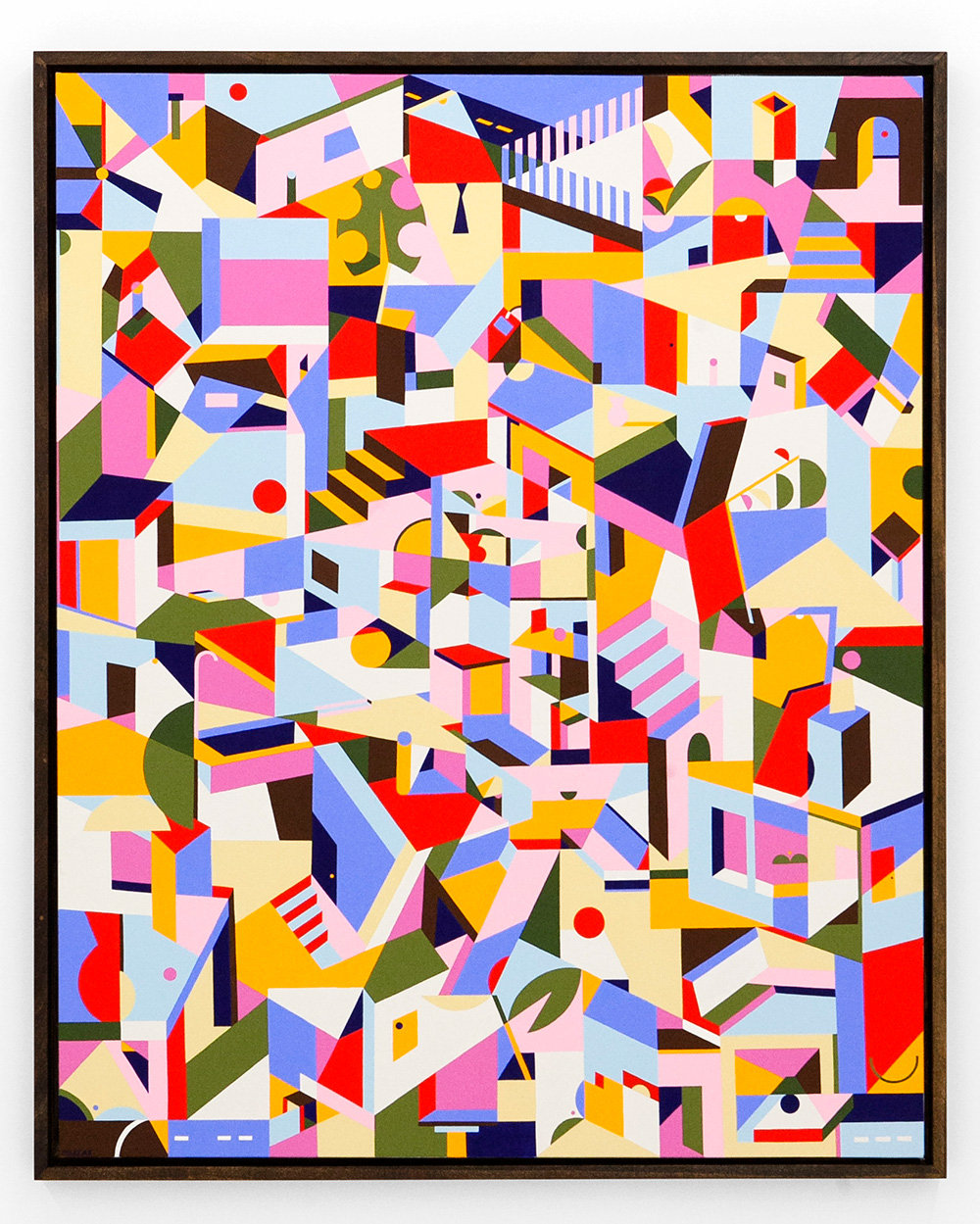
It seems like one of the consistent themes of San Francisco history has been the search for some type of enlightenment. It's a very spiritual place in that way, but historically it’s been about challenging and growing with yourself and not in a selfish, ego-driven way. Art is simultaneously the most ego-driven and least ego-driven thing that you can do. You do it for you, but in that same way, you're also doing it so you can be a better person for everyone else
In Oakland, from my perspective, creating is such a common and natural part of everyone's everyday life. People in Oakland express and nurture some form of creativity, whether it’s visual arts, writing, photography, filmography, sculpture, ceramics, fashion design, music, knitting, you name it, all working together in a small community. In Oakland, passion functions outside of capitalism. People are just out here making things and supporting each other, creating space for each other, blending creativity with activism. It's really beautiful because people don't necessarily have the same drive to be screaming, to have a global voice. People just find the thing that they like. They don't have to be the best painter in the world or the best writer in the world. That, in itself, is really refreshing, because that's kind of how I've always felt; looking at art making as a matter of fact. I think the art world is funny sometimes. My idea of the future is that everyone will just make stuff as a form of expression and a form of mental health.
But yeah, Oakland is a special place, but if you’re planning to move here without engaging with what’s going on… don’t.
@muzae
muzaesesay.com





